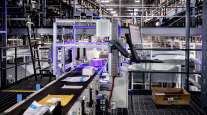Opinion: Emerging Evolution of Freight Brokerage
Every freight broker has concerns about emerging technologies. Freight and logistics always have depended on the human touch, but technology is getting smarter and many brokers wonder if their efforts will become unnecessary.
Despite the many fears, embracing change actually may propel businesses into the next generation of freight brokerage. Many changes are coming down the highway, but a simple shift in perspective may help brokers make lemonade out of lemons.

Hollingsead
Here are some changes on the horizon:
Automation: Self-driving trucks already are undergoing extensive testing on America’s roads. Otto, a San Francisco-based company, has been developing these trucks and testing them on California roadways since January 2016. Uber acquired the company for $680 million in August 2016, and testing continues today. When the concept goes mainstream, nearly 2 million truck drivers’ jobs will be at risk by the use of the technology.
Self-driving trucks certainly will lower costs for business owners. If fleet owners can save money with self-driving trucks, they are going to buy them, and a 3PL certainly will load them. It may take time to be widely accepted, though. Recently, Otto’s self-driving-truck tests have run afoul of state regulations, and many regulatory kinks still need to be worked out. Many logistics gurus predict it will be a decade or longer before self-driving trucks are a regular part of our landscape. Inevitably, there is plenty of time for brokers to integrate this concept into their livelihoods.
Drones also are growing in potential and are being explored as well, even for airfreight. According to NPR, the Federal Aviation Administration expects more than 600,000 commercial drones in the air in 2017. While photography and real estate remain the most popular commercial uses, companies are planning to use drones to deliver to remote locations that can’t be accessed by road.
While they won’t be able to deliver around the world, local delivery seems more than feasible. UPS Inc. envisions a scenario in which a driver goes up a street, parks and sends four drones to do four simultaneous deliveries. Amazon.com expects to replace a significant portion of its logistics services with drones in a move toward fast-track delivery.
Time will tell how successful these new technologies will be. But much work is left to be done before we see drones knocking on front doors. Because most 3PLs don’t do final-mile deliveries, other brokerage concerns may be worth focusing on.
Consolidations and acquisitions: Consolidations and acquisitions also have become a constant for freight brokerages. Pundits keep saying that the smaller brokers won’t be able to keep up with technology or compete with the lower margins. Meanwhile, there are more new brokers than ever, and with today’s cloud-based technology, the smaller brokers are just as efficient as the giants. By knowing about a company’s number of employees, and dollars in sales, you generally can evaluate efficiencies and make interesting comparisons among leaders.
One large industry broker, for example, has 13,500 employees and does $13.5 billion a year in sales. That’s $1 million per person in sales. Yet, there’s another market leader that does $1.7 billion with 2,400 employees. That’s only at $700,000 per person. Lots of small brokers are doing more than $1 million per person, and the most efficient in the field are at $3 million (or more).
If a 3PL is doing $2 million to $3 million a person, it can afford to undercut bigger companies, or make larger margins from the increased productivity. Interestingly, all of those consolidations and acquisitions aren’t making the larger companies any more efficient than the smaller guys.
Evolving management systems: Transportation management software may be the best place for a broker to focus its attention. Choosing the right TMS can be critical for saving time, reducing hassle and providing important process documentation. For example, one could expect Uber Freight to streamline the whole dispatch process, with drivers accepting loads in a click, and interacting with an app.
Some TMS have these features, which may help level the playing field. The more advanced TMS contain features to allow carriers to self-invoice, self-update brokers about arrivals and departures, as well as check calls and get status updates on shipments in real time. Brokers can use a TMS to help prevent getting “out-automated.”
Ultimately, those companies that stay resilient, persist and shift with the landscape are destined to survive the evolution of freight brokerage. In the end, good leadership may go a long way toward embracing change and hedging your future in this industry. Establish electronic relationships that lock you into your customers and carriers. The more you automate, the easier it will be to ensure a better future.
Aljex Software Inc. is a cloud-based freight TMS for brokers. Aljex brokers do more than $3.5 billion in transactional revenue annually.




